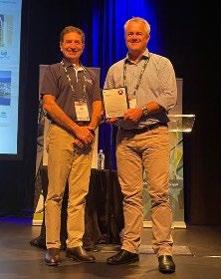SOUTH WEST QUEENSLAND
COUNCILS ARE GOING GREEN, SAVING MONEY AND MEETING COMMUNITY NEEDS
Paul Renals, Project Advisory Leader and Mike Fideli, Energy Consultant, Peak Services
Bulloo Shire Council has invested in a new watercooling system that is set to deliver significant benefits to the council and its community. The new project will cool the 70-degree celsius bore water supply which feeds the town, to a refreshing 35 degrees. The system will be powered on renewable energy, reduce water supply risk, provide data and control for council through its management system and has specifically been designed for reliability and ease of maintenance. Like many regional remote councils, Bulloo Shire Council’s community relies on water supply from bores. While water quality is potable, without treatment the water temperature is well in excess of an acceptable level when it comes out of the tap. For many years, the council has relied on a system of cooling towers and ponds although this system struggles through hot
68
Simplified layout of the cooling system.
summers, reducing the water to unsatisfactory temperatures of around 55 degrees. That is about the temperature of a hot shower, which is far from refreshing when it is over 40 degrees outside! This cooling process costs council over $70,000 annually in electricity and with much of the infrastructure nearing the end of its useful life, mounting maintenance and renewal costs have pushed the agenda for a better solution. The profit-for-purpose enterprise Peak Services, which the Local Government Association of Queensland wholly owns, has been working with Bulloo Shire Council for several years to diligently identify and evaluate the financial, technical, environmental and social benefits of numerous options. The chosen project harnesses heat exchangers and cooling towers’ efficiency to cool the 72 degrees bore water to 35 degrees at a variable rate up to 30 l/s. The cooled water is stored
in three 500 KL water storage tanks. Multiple variable speed pumps work to meet community demand for up to 45l/s at a constant pressure to meet peak demands. The project is entirely powered using renewable energy, reducing the risk of grid supply issues that are common in remote locations. This significantly reduces the cost of the operation with associated environmental benefits also achieved. The 240kW solar power plant is designed to power all system components during the day, with sufficient capacity to charge the 583kWh battery storage for uninterrupted operation during night and low solar insolation periods. The renewable energy capacity is adequate to cool, treat and deliver up to 1.5ML of potable water per day to the community. The system is managed through a water management system that constantly monitors and
ENGINEERING FOR PUBLIC WORKS | MARCH 2021



























